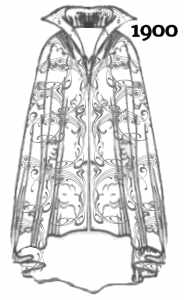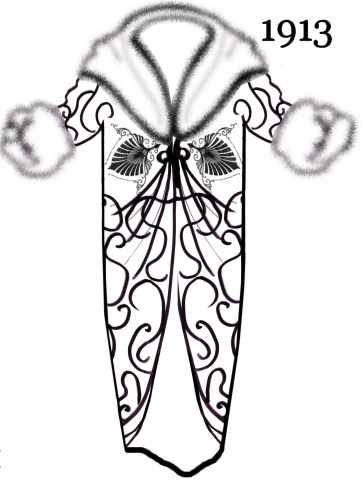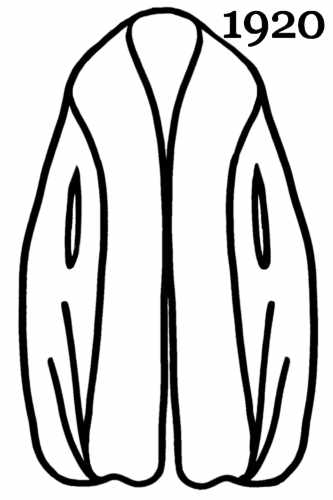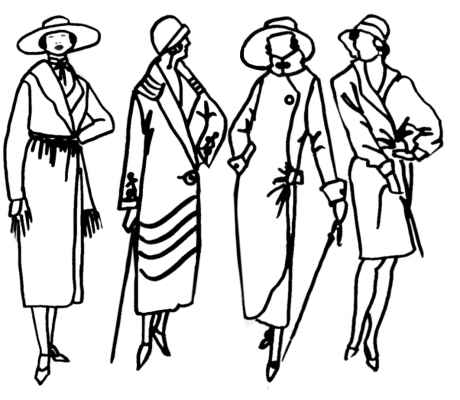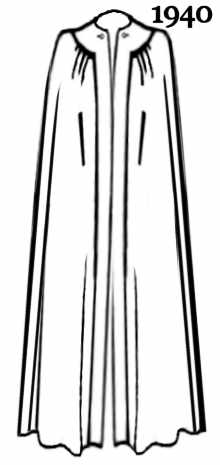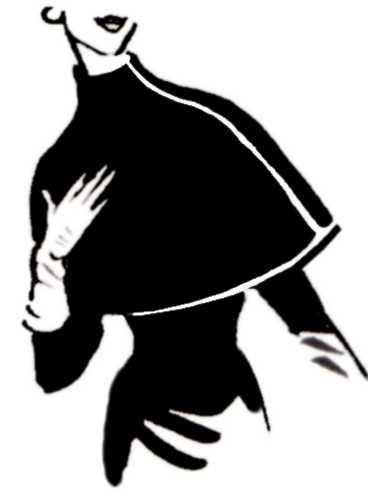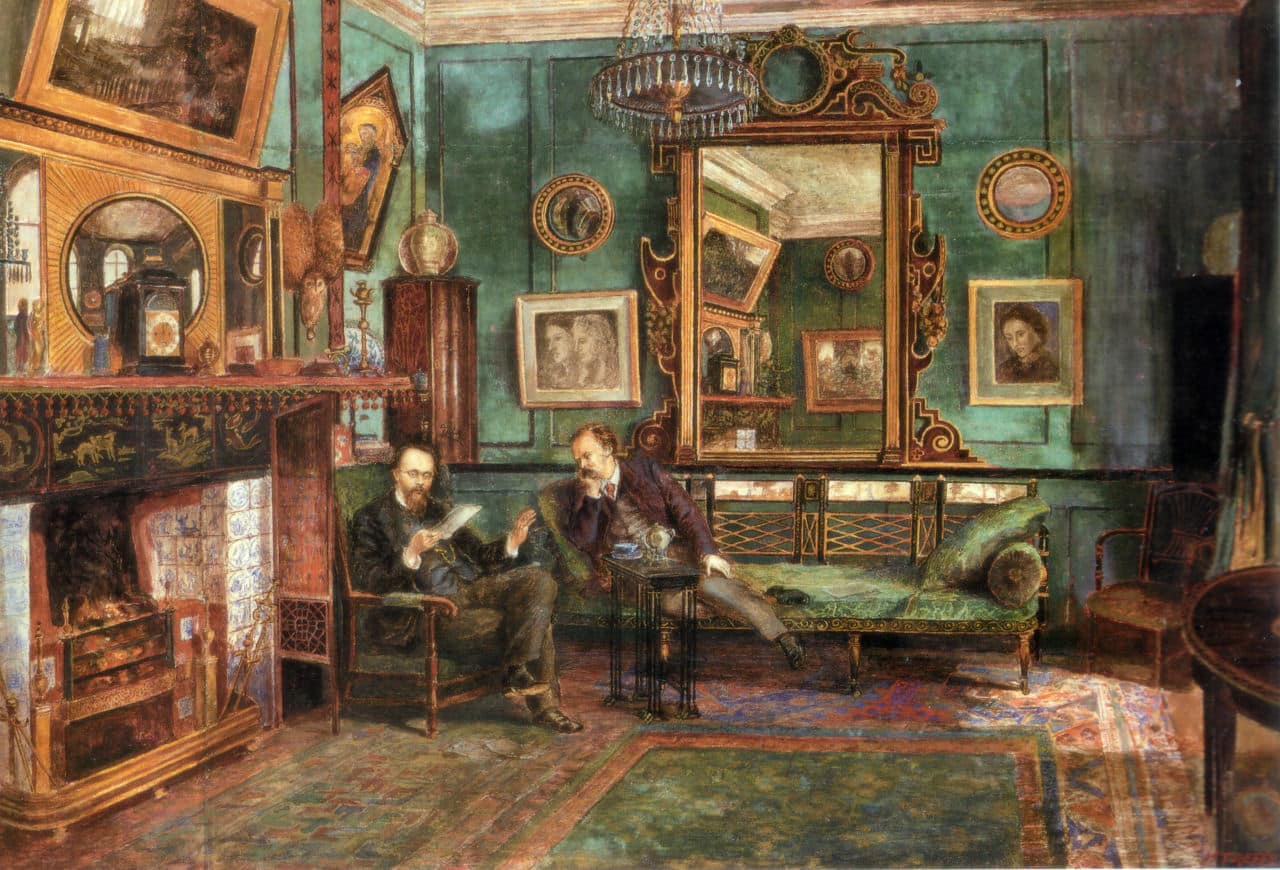By Pauline Weston Thomas for Fashion-Era.com
- Capes and Cloaks
- 1920's Mantle Cloaks
- The 1930's Fashion for Cloaks
- The 1950s Cape
- Stoles
- The Poncho Cape
- The Pareo
- Pashminas
- Capes and Capelets 2009
Capes and Cloaks
New styles of coats emerged during the 1900s. Many were a cross between a cloak and a coat. Cloak styles showed new influences and often had trailing art nouveau patterns with oriental inspired lines.
The change in silhouette around 1908 and the trend to a straighter columnar slimmer silhouette by 1911 meant that coat garment designs that looked much more 20th century flooded the marketplace. Cloaks lost favour as the new century took hold. By 1910, although some sturdy outdoor tweed versions were still used, cloaks were worn less and less.
In the main, cloaks soon became more associated as a uniform for nurses and service workers, rather than a fashion item. The fashion style the nurse's cloaks followed, harked back though to another age and are reminiscent of the first two full-length cloaks on the Cloaks 1 page.
1920's Mantle Cloaks
By the 1920s modern versions of cloaks similar to easy fitting cocoon styles emerged as garments for evening. In the main most coats of the 1920s wrapped to one side and is always a strong style feature of most 1920's coats whatever their length.
These 1920's cloaks shown here are similar to the styles Romeo Gigli used as inspiration in the 1980s and 90s for his fabulous velvet and embroidered styles that brought gasps from his clientele.
The 1930's Fashion for Cloaks
The next time cloaks really became a fashion force with the young chic woman about town was in the 1930s. 1930s capes and cloaks, teamed with bias cut skirts and dresses have stylish look about them. Some cloaks merged into coats almost and the cape influence is strongly shown in the shoulder lines of many fashion drawings of coats and jackets of the era.
Small capes also made the perfect cover up for a backless dress. Some of these merged into the bolero cum spencer styles also so useful with halter top dresses.
Long Cloaks were also the ideal cover up for the full evening length dresses of the 1930s.
The 1950's Cape
The cape emerged again as an updated fashion statement in the 1950s. Paris designers often favoured simplified lines and for bulky tweedy, check and mohair fabrics the easy lines of a cloak were perfect to show the fabric to perfection.
A short cape was promoted in 1955 and this example shows a picture from a magazine of 1955.
This style was also adapted and used to make short mink or other fur wraps with kimono set sleeves, popular in the 1960s.
Stoles
Stoles added glamour to outfits of the 1950s and early 1960s. Stoles from this period were about glamour and style. Stoles dressed an evening outfit and covered a bare back with shoestring straps. Often made of slub silks or dull satins, the stole ends would sometimes be embroidered and fringed.
Contrast linings were frequently used in dramatic colour combinations such as black velvet lined with gold or perhaps emerald green thick lustrous satin. Quality machine made cotton lace versions were also popular.
For those with money the ultimate stole of the 1950s was the white mink stole. But all stoles soon disappeared when the 60's mini made the look old fashioned and dated. But for real glamour think 50's film stars with cleavage and an artfully draped stole.
When Did Capes Go Out of Style?
So the cloak and cape came in and out of fashion just as it had during the 19th century.
The Poncho Cloak
One very interesting variation on this was the poncho cape a fashion of the 1970s.
Ponchos existed in just about every possible variation from crochet versions to the more rustic, Clint Eastwood style Mexican poncho. The crochet poncho version spawned a variation in the circular crochet granny shawls popular in the early 1970s.
The Pareo
By 1980 the poncho had morphed into the Pareo. A long length of wool fabric, either woven or knitted, about 70 to 80 inches long and made from 60 inch to 72 inch wide cloth that was slit and very lightly shaped part way up the centre fold. Pareos were popular in the late 1980s and the 1990s and can be referred to as a wrap. They are a great item for fancy dress use.
Pashminas
In the 1990s black was the only shade to wear. Colours based on primary and secondary hues seemed to disappear from sight until the late 1990s.
But the sea of black was suddenly brightened by a flurry of pashmina shawls. They served as warm neck wraps on chill winter days and tied in the Fulham knot by those in the know, the incredible bulk of the item was soon reduced and became easily wearable as a neck accessory.
At around the same time about 1997, feminine dresses in bright silks became usual. On cool summer evenings, to cover their arms, whether toned or flabby, women donned colorful pastel-toned Pashmina shawls to accessories crepe de chine silken dresses.
The formal jacket was relegated to the office as part of the trouser suit and deemed too formal for fun events where a softer, more feminine look was sought. Pashminas were the perfect solution and brought a fresh feel to wedding and evening outfits in particular.
So the Pashmina shawl softened the drab coat colours, and also doubled as a warm stole wrap on summer evenings and at cold winter venues.
By the year 2000 the Pashmina was a mass fashion and many moved onto newer ideas. Many though saw the millennium new year's eve in wearing semi sheer iridescent long stoles designed exactly just like a pashmina shape and with similar dimensions.
It did not go away however as many found it so useful. It returned with expensive embroidery or beadwork in 2001 and many women always pack a pashmina for continental holidays as it is a perfect item for a quick cover up near a cool sea breeze. It also can be used as a grass blanket when the only place to sit is the ground.
Capes and Capelets 2009
Capes and capelets make a recognised return for autumn 2009. Designers have toyed with capes for a couple of years but only in 2009 did the average person start wearing them again.

